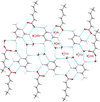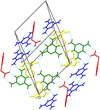issue contents
November 2024 issue

Cover illustration: The properties of N-(5-nitrothiazol-2-yl)furan-2-carboxamide, as a potential inhibitor of the DHODH (dihydroorotate dehydrogenase) enzyme, were evaluated by molecular docking, showing coupling energies very close to those obtained with the control drug for rheumatoid arthritis, i.e. leflunomide. See Monge-Hoyos, Moreno-Fuquen, Arango-Daraviña, Ellena & Santiago [Acta Cryst. (2024), C80, 707–715]. (Part of the collection Crystallography in Latin America: a vibrant community)
scientific commentaries


crystallography in latin america




research papers


 access
access










 journal menu
journal menu



























